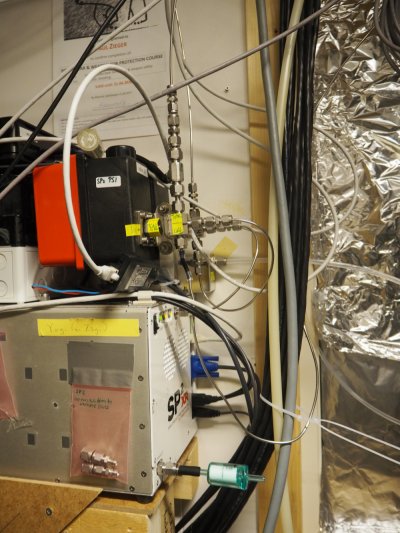The goal of the 2019 SIOS access project AC/BC was to initiate the first longer-term measurements of Black Carbon (BC) concentrations and properties in the air and clouds at the Zeppelin Observatory above Ny-Ålesund with an extended-range single particle soot photometer (SP2-XR; Droplet Measurement Technologies Inc.) – a newly developed and highly sensitive aerosol instrument designed to operate continuously and unattended. The project was conducted by researchers from the Paul Scherrer Institute in Switzerland (R. L. Modini (PI), R. Pileci, G. Wehrle) in close collaboration with partners from Stockholm University (P. Zieger, R. Krejci) and station staff from the Norwegian Polar Institute.

switching system running in place at Zeppelin Observatory.
In March 2019 PSI researchers R. Pileci and G. Wehrle travelled to Ny-Ålesund for 10 days in order to install the SP2-XR instrument in the Zeppelin Observatory. A automated valve-switching system was combined with the instrument so that it could measure behind both the total air and cloud sampling inlets when clouds pass the site. The combined system was successfully plumbed into the existing air sampling lines setup by our partners from Stockholm University. An initial partial-calibration of the instrument was performed once the instrument was in place. Data logging was initiated and the instrument has run continuously since then, detecting and recording a signal from every single black carbon particle (within a certain size range) that passes through the instrument.
The quality of data collected by the SP2-XR depends on how well the instrument is calibrated – regular calibrations are required to ensure high quality measurements. Calibrating the SP2-XR means passing artificially-generated black carbon and purely scattering particles of known diameters through the instrument in order to generate calibration curves linking the instrument response to particle size or mass. A calibration unit was constructed for this purpose at PSI in April and May 2019. In June, R. Modini travelled to Ny-Ålesund for 7 days to calibrate the SP2-XR with this new unit. Excellent calibration curves were obtained that demonstrated the instrument had operated stably since it left PSI with relatively little detector drift. In November 2019, R. Pileci and G. Wehrle travelled again to Ny-Ålesund, this time for 7 days, in order to perform another calibration. Excellent results were again obtained, consistent with the calibration performed in June. One final calibration of the instrument is planned in Spring 2020 when the measurement period will finish and the instrument will be retrieved.

the opportunity to observe Zeppelin mountain and the Observatory beneath the northern lights (photo credit: R. Pileci).



























